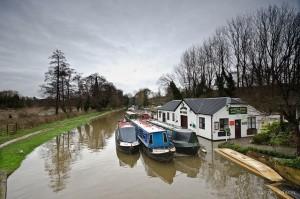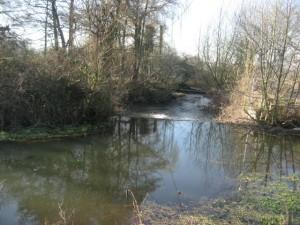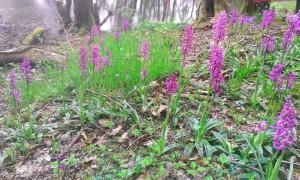This is the third in a series of articles on Water and the Landscape. The other articles Part 1, Part 2, Part 4.
What lessons can be learnt from this year’s flooding in the UK?

Firstly, long term landscape management is vital. Long term landscape management and landscape planting will help to combat, mitigate and alleviate effects of flooding. The UK government slowing down implementation of Schedule 3 of the Flood and Water Management Act 2010 has meant developers have not felt compelled to construct sustainable drainage as part of new construction. The Landscape Institute have written a landscape and water briefing paper.
Flooding will unfortunately continue to occur with increasing frequency and regularity; due to the effects of climate change. If no action is taken now, on long term management issues in the landscape, costly flood damage and months of misery will again occur. Home holders and business owners in low lying areas are most at risk. What, therefore, do we need to do now?
Flood risk Management
It is well known that in depth knowledge of the landscape, geology and soils are vital in landscape design and management. These elements, with topography and land use, are important in flood alleviation and drawing up mitigation for new developments. Planting of trees and creation of the right habitats can help to slow down rates and to decrease volumes of water run off. Hence, appropriate landscape management can vary the degrees and intensity of flooding.
Having an integrated approach to Sustainable Urban Drainage Schemes, widely known as SUDs, with a whole catchment approach, can mean the difference between vast areas being flooded or the damage being contained within smaller areas. It can also mean that lives and livelihoods can be saved. In addition, this approach can bring water quality and biodiversity benefits.

There are many elements of the natural landscape which can be used to help facilitate water retention; slowing water down can also bring additional biodiversity benefits.
Management of whole river catchments.
The methods of water and landscape management of upstream catchments, can entail creation of new water bodies, tree planting and creation of new long term wildlife habitats, supporting rare or endangered species. Woodland areas in particular, can form an important recreational resource as wild areas, accessible for tourism and as areas of retreat for locals.
Water and landscape management, with design and management to alleviate flooding, includes habitat creation of ponds and water bodies, tree planting areas, restoring blanket bog and heather moorland. These methods of managing upstream river catchment areas are vital in helping to minimise the effects of high water flow rates on downstream flooding. The down stream areas are low lying areas and river valleys that we have recently witnessed flooding in southern England (2014.)
Further downstream, wet woodlands can be planted. Tree canopies enable a third of rainfall to be intercepted and returned to the air through evaporation. The remaining two thirds of the rain is also slowed down by trees which increase the surface “roughness” dramatically. The woodland floor of broadleaved, deciduous woodland, is composed of a thick layer of leaf litter which acts like a sponge, soaking up surface water and intercepting it; slowing down rates of surface water flow. Planting trees in wet woodlands and in urban areas thus helps to slow down water flow rates and also improves air quality. Increasing surface roughness of unimproved pasture, wet meadows and marshland, can act like a “giant sponge” to water and increase water holding capacity. Landvision has wide experience of creating new habitats and specialises in ecological design of habitats.

In this way, landscape design and management, which includes design of wetland areas, woods, and other elements which increase incidence of water slowing, such as larger water retaining bodies in the landscape, can all bring benefits. Ecosystem services include increased safety, by slowing down water flow rates and decreasing the intensity of overall flooding. These are clear benefits for landowners and residents of river catchment areas which are affected by flooding.
The nature of river catchments, their differing characteristics (slopes, soil, hydrology, vegetation cover and types of land management) coupled with the changeable weather systems that bring high rainfall events, mean that predicting and pinpointing flooding, is not always easy. Flood modelling systems are becoming more efficient and this is combined with increased awareness of need for sustainable urban drainage and sustainable management of upper river catchment areas to combat flooding.
Upper river water storage systems, can be useful for times of drought when water resources are in demand. Thus, a whole river catchment approach to build and create resilient landscapes, is required.
Sustainable Urban Drainage (SUDs) is very important in urban areas. SUDs are vital in aiding increased sustainability and management of water resources in the landscape. SUDs can be retrofitted to existing landscaped and urban areas, such as car parks. SUDs will slow down water flow rates, by intercepting water from urban areas and storing it in underground chambers as well as in newly designed bogs and overflow ponds.
Without the use of SUDs, water flows are speeded up by the increased incidence of hard surfacing from paved over driveways and new developments and drainage systems. Runoff from roofs and impermeable car parks also greatly increase the rates of water flow into river systems. This is particularly a problem in urban areas and lack of SUDs increases the likelihood of flooding in built up, low lying areas, during peaks of high rainfall.
W,hen this peak rainfall coincides with Spring tides, damage caused to land and property in coastal areas downstream and in river floodplains can be considerable as seen in recent flooding in Somerset and along the Thames valley in 2013/ 2014.
Tree Planting.
Urban forestry has dramatically declined in the UK. This trend needs to be reversed and more urban trees planted as part of SUDs systems.
In the uplands, soil erosion is occurring following past overgrazing of highland pastures and moorlands. Here, the urgent need is for re vegetation of bare soil areas, by replanting of vegetation, with root systems to bind the soil together and with planting of tree species.
Soils being washed away, pollute water courses, as well as causing infrastructure problems to road and rail networks. This was seen in the recent landslides in Surrey and Sussex in 2013/14. Tree planting and sensitive tree management is thus vital, to counteract pollution of water courses and disruption to road and rail services; preventing landslides, which are a form of ecosystem “crash”. Similarly, in wetland landscapes, tree planting will have an important defensive role against floods. Trees will often be replanted; these trees can replace those lost from areas where they used to grow, if space allows. Sensitive design and management of tree planting can thus be another effective way to alleviate the effects of flooding.
For more information on techniques to help to alleviate flooding and to mitigate against flood damage, contact Landvision now on 01892 782200.
